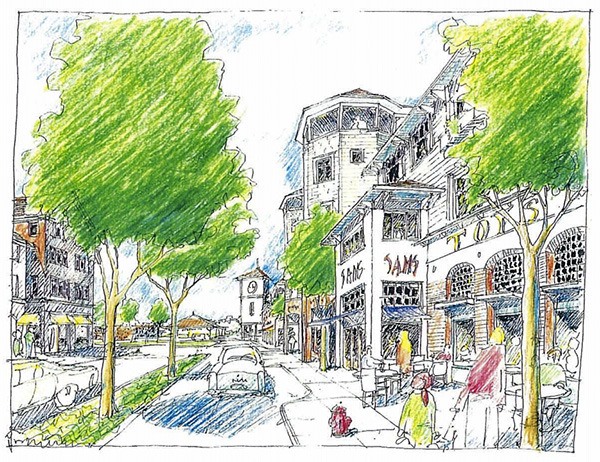Interested citizens will have a chance to voice their opinions on Town Center — whether they want to see more local restaurants and retailers, a central public gathering area or more parking — in the coming months.
At the City Council meeting on Feb. 23, staff presented plans to engage the community in the development of Town Center. Nine people were appointed to a Town Center Liaison Group, which plans to meet the week of March 9 with the city’s urban planning consultant and stakeholder group to continue the visioning work that started last year.
For Islanders who have seen the Central Business District evolve from its own town to a sea of strip malls to a semi-urban neighborhood, the concern about the density in and “vision” for the area is history repeating itself.
The city went through a similar process 20 years ago, after a five-story corporate center was built 1987 and the Growth Management Act (GMA) was enacted in 1991.
In response to citizen concerns and to plan for the population growth in Mercer Island, a group of consultants, developers and Islanders — including Chamber of Commerce Executive Director Terry Moreman and former Councilmembers Peter Orser and Susan Blake — participated in a “citizen visioning” process in 1994. The three met with the Reporter last week to talk about how the Town Center in 2015 compares to their 1994 vision.
“Back when this code was written, there were seven hamburger joints downtown and one pizza parlor, and now there’s seven pizza parlors and one hamburger joint,” Blake said. “Things change.”
One thing hasn’t changed: the desire for a vibrant, walkable, friendly downtown village.
They planned to accomplish that with mixed use buildings in the three to five story range, depending upon whether or not developers choose to receive density and height bonuses in exchange for “significant” amenities.
Last year, the city hired consultant Seth Harry to look at the code and ask if the amenities are significant enough.
“That’s part of the lessons learned and the evolution,” Orser said. “As a community we’re getting better, and learning from our experiences.”
The 1994 group wrote a code with incentives rather than prescriptive rules because they “didn’t want to be Leavenworth.” Instead, they planned to use the city’s Design Commission to vet building plans before they came into fruition.
“Every project has a color or a feature that wouldn’t have been my choice, but there’s only so much you can dictate,” Orser said. “One person’s charm is another person’s dump. You have to look at it as a whole canvas, not project by project.”
Looking back on it now, they say Town Center isn’t as charming as they envisioned. Plazas that were supposed to be public are blocked off, and some storefronts are empty.
But it is becoming a neighborhood, with more people shopping, dining walking and using mass transit. Town Center is still evolving, and events like Art Uncorked show it has the potential to be a community gathering space, Orser said.
Some portions of the vision haven’t been realized. With Harry, the city is revisiting a few ideas from 1994, like requiring setbacks and varied building heights and adding a central plaza and anchor retailers. Harry used examples of Trader Joe’s and Whole Foods in a December presentation.
A contentious part of the 1994 plan has been the five-story height limit. Some Islanders today say that the taller buildings are ruining the “village feel,” that added density is overloading Island schools and infrastructure, and that developers should give more to the city, whether in impact fees or public amenities, to go up to five stories.
The five-story limit was a conscious decision by the 1994 group, which agreed that the downtown core could most easily accomodate the growth predicted by the GMA, and that more people living downtown would also mean more support for local businesses.
“Change is inevitable. You just have to manage it, for now and for the future,” Blake said. “We now have a vibrancy in Town Center that we’ve never had before.”
It took a lot of courage to open a business in downtown Mercer Island in 1994, Moreman said: “They just didn’t last.”
There are now businesses like Bennett’s, Homegrown and soon, Pagliacci Pizza.
City officials seem to agree that the city hasn’t asked for enough in exchange for height bonuses. They have been talking to Hines about adding commuter parking and a Whole Foods. Harry said that definition of “amenity” is “too ambiguous in purpose, or conflicting in application, to consistently deliver the kind of meaningful public space described by the intent language of the code.”
The city has volunteers on its Design and Planning Commissions to interpret the ideas, plans and codes and apply them to new projects. But that doesn’t mean that the plan, or the interpretation, is flawless.
Councilmembers agree that the 1994 vision is still good, but needs “tweaking,” especially as the city updates its GMA-mandated Comprehensive Plan.
With the Comp Plan update and Town Center vision occurring simultaneously, the city imposed a moratorium to slow down development and communicate with the public.
A public hearing on the moratorium is set for March 2. A two‐day workshop to analyze public input and suggest changes to the development code is scheduled for March 20‐21.


